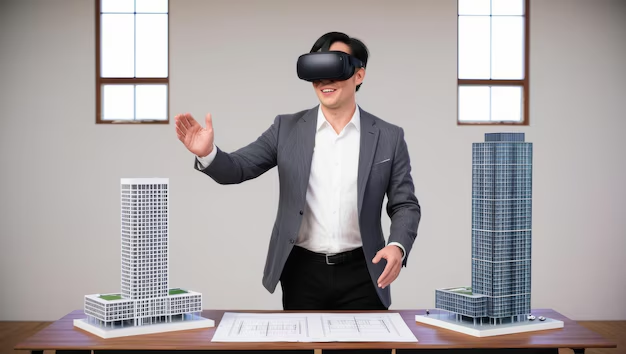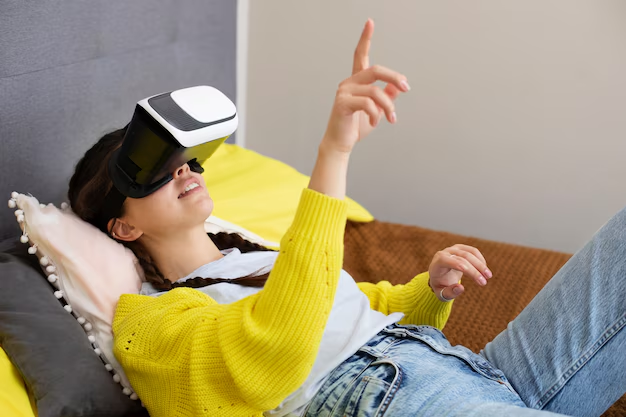Virtual reality (VR) technology has grown exponentially over the past decade. VR headsets have evolved from niche gadgets to mainstream devices, capturing the imaginations of gamers, tech enthusiasts, and even casual users. Among the many contenders in the market, the Meta Quest 2 (formerly Oculus Quest 2) stands out as the number one selling VR headset globally. Its rise to the top is attributed to its affordability, accessibility, and impressive features that appeal to a wide range of users. This article explores the journey of Meta Quest 2 to the top, analyzing its design, performance, features, and how it compares to competitors in the VR landscape.
The Rise of Meta Quest 2
The Meta Quest 2 was launched in October 2020, developed by Oculus, a division of Facebook (now Meta). It built upon the success of its predecessor, the Oculus Quest, but brought numerous improvements in terms of hardware, software, and overall user experience. Meta Quest 2 quickly became the go-to VR headset, dominating sales charts worldwide.
There are several key factors that contributed to its overwhelming success:
- Affordable Price Point: At launch, the Meta Quest 2 was priced at $299 for the base 64GB model, significantly cheaper than other high-end VR headsets. This affordability made it accessible to a broader audience, including casual gamers and first-time VR users. Many VR headsets require a powerful gaming PC or console, but the Quest 2 operates as a standalone device, which reduces the overall cost of entry.
- Standalone VR Experience: One of the major selling points of the Meta Quest 2 is its standalone capability. Unlike other VR systems that require an external console or PC to run VR experiences, Quest 2 has its own built-in processor, the Qualcomm Snapdragon XR2, along with 6GB of RAM. This eliminates the need for cumbersome wires or high-end gaming setups, making VR more user-friendly and less intimidating for newcomers.
- High-Quality Display: The Meta Quest 2 features an impressive display resolution of 1832 x 1920 pixels per eye, providing a sharp and immersive visual experience. This is a significant improvement over its predecessor and rivals many of the more expensive headsets on the market. The smooth frame rates of up to 90Hz (and 120Hz in some apps) further enhance the overall immersion, allowing users to enjoy a fluid and responsive virtual environment.
- Ease of Use: Setting up the Meta Quest 2 is incredibly simple. Users can easily connect to Wi-Fi, log into their Oculus account, and start downloading VR content. The device features inside-out tracking, meaning it uses external cameras built into the headset to track the user’s movements, eliminating the need for external sensors. The lack of external sensors or wires makes it portable and allows for quick play sessions, which has been a huge draw for casual gamers.
- Wide Content Library: Another significant factor in the Meta Quest 2’s dominance is its vast content library. The Oculus Store boasts hundreds of games, apps, and experiences that cater to various tastes. Popular games like Beat Saber, Superhot VR, and The Walking Dead: Saints & Sinners have drawn users in, while fitness apps like FitXR and Supernatural have shown that VR isn’t just for gaming but also for exercising. The variety in content means that there’s something for everyone, which has helped the Quest 2 attract a diverse user base.
- Cross-Platform Compatibility: In addition to being a standalone headset, the Meta Quest 2 can connect to a PC via Oculus Link or wirelessly using Air Link. This feature allows users to access more graphically demanding VR experiences that require the power of a gaming PC. This flexibility makes it a versatile option, catering to both casual and more serious VR users who want to play PC VR games like Half-Life: Alyx or Elite Dangerous.
Design and Comfort
The Meta Quest 2’s design strikes a balance between functionality and comfort. It is lighter than its predecessor, weighing in at 503 grams (about 1.1 pounds). This reduction in weight, combined with a streamlined design, makes it more comfortable to wear for extended periods, which is crucial for a device meant for immersion.
The head strap, however, has been a point of contention for some users. The standard strap is made of elastic fabric, which works fine for casual users but may feel less secure during intense gaming sessions. To address this, Meta offers an optional Elite Strap (sold separately), which provides better stability and comfort for long-term use.
The adjustable IPD (interpupillary distance) slider allows users to adjust the lenses to better suit their eye alignment. This ensures that the visual experience is optimized for different users, reducing the likelihood of eye strain.
The device’s ergonomic controllers also contribute to a comfortable and immersive experience. The Oculus Touch controllers are lightweight, responsive, and equipped with intuitive button layouts that make it easy to interact with the virtual world.
Performance
The Meta Quest 2’s Qualcomm Snapdragon XR2 processor delivers a significant performance boost over its predecessor, the Oculus Quest. This dedicated VR/AR chipset is powerful enough to handle the demands of modern VR applications, offering smooth and responsive gameplay. The 6GB of RAM complements the processor, ensuring that multitasking and demanding apps run smoothly.
While the Quest 2’s onboard storage options (64GB and 256GB models) may seem limiting compared to traditional gaming systems, it’s generally sufficient for storing several VR games and applications. Most games on the Oculus Store are relatively small in size, though the lack of expandable storage means users must manage their content carefully.
Another notable performance feature is the device’s ability to run at 90Hz and 120Hz (for select apps). This higher refresh rate provides a smoother and more comfortable experience, particularly for fast-paced games and action-packed experiences. It reduces the “screen door effect,” where users can see individual pixels, which is a common issue with lower-quality VR headsets.

Content and Ecosystem
One of the Meta Quest 2’s biggest strengths lies in its robust ecosystem. The Oculus Store offers a wide variety of games, apps, and experiences that cover multiple genres. Whether you’re into action games, puzzle-solving, fitness, or social VR, there is something for everyone.
Popular Games and Apps
- Beat Saber: A rhythm game where players slash blocks to the beat of the music, Beat Saber has become one of the most popular VR games of all time. Its simple yet engaging gameplay and regular updates make it a favorite among Quest 2 users.
- Superhot VR: In this innovative first-person shooter, time only moves when you move. This unique mechanic adds a strategic element to combat, and the game’s minimalist design works well on the Quest 2’s hardware.
- The Walking Dead: Saints & Sinners: This survival horror game immerses players in a post-apocalyptic world where they must fight zombies, scavenge for supplies, and make critical decisions to survive.
- Rec Room: A social VR platform where users can create, play, and explore different games and environments with other players. It has become a hub for social interaction within the VR space.
- FitXR and Supernatural: These fitness apps have gained popularity as users seek to combine exercise with fun. With guided workouts, boxing routines, and dance-based exercises, these apps have helped position the Quest 2 as a tool for both entertainment and health.
Cross-Platform Play
While the Quest 2 can run standalone apps, it also supports PC VR gaming through the Oculus Link feature. By connecting the Quest 2 to a gaming PC, users can access high-fidelity VR games available on platforms like SteamVR. This feature expands the content library significantly, giving users access to titles like Half-Life: Alyx and No Man’s Sky.
In addition to gaming, the Quest 2 supports various productivity and social applications. VR is increasingly being used for virtual meetings, creative collaboration, and even virtual offices. Apps like VRChat, AltspaceVR, and Horizon Workrooms allow users to socialize, collaborate, and interact in virtual environments, bringing the vision of the Metaverse closer to reality.
Competitors
Despite its success, the Meta Quest 2 faces competition from other VR headsets in the market. Some of the notable competitors include:
- Valve Index: Known for its high-quality build, superior tracking, and advanced controllers, the Valve Index offers a premium VR experience. However, it is much more expensive than the Quest 2 and requires a powerful gaming PC, which limits its accessibility.
- HTC Vive Pro 2: The HTC Vive Pro 2 is another high-end option that boasts a higher resolution display and precise tracking. It is targeted at professionals and serious gamers but comes with a steeper price tag and more complex setup.
- PlayStation VR 2: Sony’s upcoming PlayStation VR 2 is designed for use with the PlayStation 5 and is expected to offer high-quality VR experiences for console gamers. While it doesn’t offer the same flexibility as the Quest 2, it could capture a significant portion of the console gaming market.
- Pico 4: A lesser-known competitor, the Pico 4 offers similar features to the Meta Quest 2, including standalone operation and wireless PC VR support. While it has gained traction in certain regions, it hasn’t yet achieved the same level of market penetration.
Challenges and Criticisms
While the Meta Quest 2 is the best-selling VR headset, it isn’t without its challenges and criticisms. Some users have reported discomfort during extended play sessions, particularly due to the elastic head strap. Upgrading to the Elite Strap improves comfort, but it comes at an additional cost.
Another point of concern is the requirement to log in with a Facebook account. This has been a controversial issue for many users who prefer to keep their social media and gaming experiences separate. While Meta has announced plans to ease this requirement, it remains a point of contention.
Future of Meta Quest and VR
The success of the Meta Quest 2 has paved the way for continued innovation in the VR space. Meta is reportedly working on new hardware, including the Meta Quest 3, which is expected to bring further advancements in processing power, display quality, and immersive capabilities.
As the VR market continues to grow, the future holds exciting possibilities. The development of the Metaverse, a concept championed by Meta, suggests that VR will play an increasingly important role in social interaction, work, education, and entertainment.
Conclusion
The Meta Quest 2’s dominance as the number one selling VR headset is well-deserved. Its affordability, ease of use, versatility, and rich content library have made it a standout product in the crowded VR market. While it faces competition from higher-end devices like the Valve Index and HTC Vive Pro 2, the Quest 2 strikes a balance that appeals to both casual users and VR enthusiasts.
By democratizing access to virtual reality, the Meta Quest 2 has not only solidified its place as the top-selling VR headset but also helped bring VR into the mainstream. As the technology continues to evolve and the VR ecosystem expands, the Quest 2 will likely remain a key player in the future of immersive entertainment and beyond.
